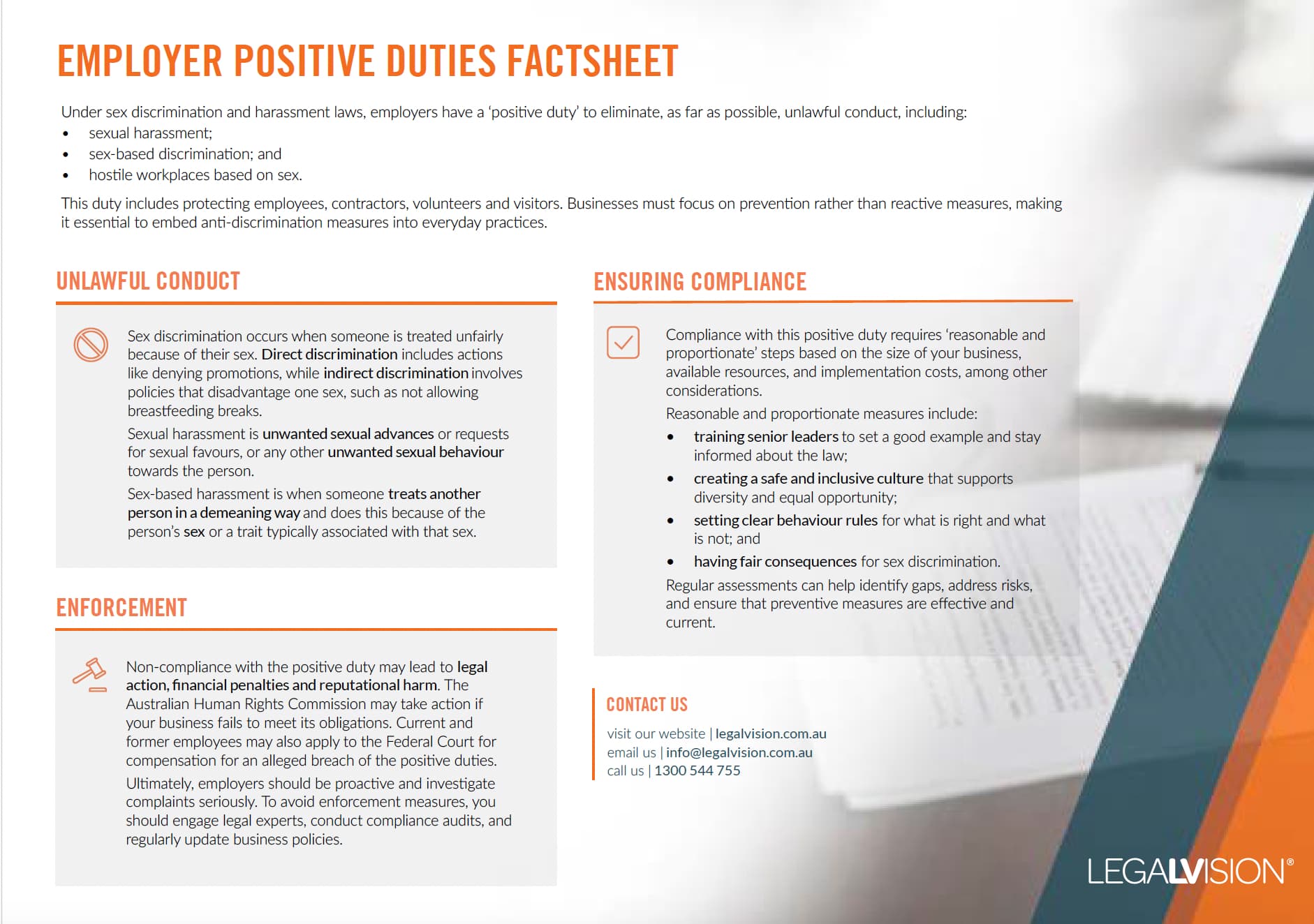In Short
- Sexual harassment laws apply to all businesses under federal and state legislation. Employers face legal risks if they don’t take reasonable steps to prevent it.
- Employers have a positive duty to eliminate unlawful conduct. This includes policies, training, and clear reporting procedures.
- From March 2025, Queensland businesses must have a written prevention plan or risk enforcement action.
Tips for Businesses
Review your workplace policies, train staff on expected behaviour, and implement easy-to-use reporting channels. Tailor your approach based on your business size and risk level. In Queensland, prepare for the new March 2025 prevention plan requirement. A proactive approach helps protect your team—and your business.
Presented by Dickson Wu (Senior Lawyer) and Ellie Kenny (Lawyer), LegalVision Employment & WHS Team
Summary: This article summarises a recent employment law webinar presented by Dickson Wu and Ellie Kenny. It outlines the key legal obligations and practical strategies for preventing and responding to sexual harassment in Australian workplaces. Designed for business owners and in-house legal counsel, the session covered federal and state legal frameworks, the definition of sexual harassment, and actionable compliance steps.
Key Topics Covered:
- Legal obligations under WHS laws, the Sex Discrimination Act and the Fair Work Act
- Definition of sexual harassment and illustrative examples
- Positive duty to prevent unlawful conduct
- Queensland’s new written prevention plan requirement
- The Australian Human Rights Commission’s (AHRC) Seven Standards
- Best-practice policies, training, and risk assessment tools
- Responses to common scenarios and employer responsibilities

This fact sheet outlines employers’ ‘positive duty’ under sex discrimination laws, highlighting proactive measures to prevent unlawful conduct.
Hello and welcome to LegalVision’s webinar on “Sexual Harassment: What Every Business Needs to Know Now”. I’m Dickson Wu, a Senior Lawyer in LegalVision’s Employment and Work Health & Safety team, joined by my colleague Ellie Kenny, also a Lawyer in the team.
We also ran a poll asking attendees what they most wanted to learn. The top responses were “All of the Above”, including legal obligations, compliance tips, WHS duties, and understanding what constitutes sexual harassment. So you’re in the right place. Let’s dive in.
Understanding the Legal Obligations
Across all jurisdictions in Australia, sexual harassment is prohibited. Legal duties stem from three main sources:
- Work Health and Safety (WHS) Legislation (State-based)
- Sex Discrimination Act 1984 (SDA) (Federal)
- Fair Work Act 2009 (FWA) (Federal)
WHS Duties: Under state and territory WHS laws (excluding Victoria, which uses OHS laws with similar effect), a person conducting a business or undertaking (PCBU) must ensure, so far as is reasonably practicable, that workers are not exposed to risks to their psychological or physical health. This includes risks from psychosocial hazards such as sexual harassment. Failure to do so may result in regulatory penalties, including fines and even imprisonment.
Positive Duty Under the SDA: Employers must take reasonable and proportionate measures to eliminate, as far as possible, unlawful conduct including sexual harassment, sex-based harassment, discrimination, and victimisation.
Reasonableness is assessed by:
- Size and nature of the business
- Financial and other resources
- Practicality and cost of controls
- Any other relevant factors
Employers are vicariously liable for employee misconduct unless they can demonstrate they took reasonable steps to prevent it. Civil penalties and compensation may apply.
Fair Work Act Changes: The FWA now explicitly prohibits sexual harassment at work. Employers can again be vicariously liable for inaction.
Queensland’s New Requirements: From 1 March 2025, Queensland businesses must:
- Prepare a written prevention plan
- Identify and assess sexual harassment risks
- Document control measures and consultation processes
- Include a reporting procedure that is accessible and easy to understand
Failure to comply may result in enforcement action and weakens the employer’s legal defence.
What Is Sexual Harassment?
Sexual harassment is:
Any unwelcome sexual advance, unwelcome request for sexual favours, or other unwelcome conduct of a sexual nature that makes someone feel offended, humiliated or intimidated, where a reasonable person would expect that reaction.
Factors include the person’s:
- Age, gender, sexual orientation, race, disability, and religious belief
- Relationship to the person engaging in the conduct
Examples include:
- Unwanted physical contact
- Sexually suggestive comments or jokes
- Inappropriate questions about appearance or personal life
- Sexual gestures or exposure
- Sending explicit images or gifts
Case Study – Victoria, 2025: A painting company was fined $90,000 after a worker was subjected to 60 days of harassment, including personal remarks, inappropriate physical contact, and coercive behaviour. The business had no sexual harassment policy in place.
The court found that the company could and should have implemented basic risk controls, including a reporting process and training.
Preventing Sexual Harassment: The AHRC Framework
The Australian Human Rights Commission outlines seven standards to guide employers:
- Leadership:
- Leaders must set the tone and actively challenge inappropriate conduct.
- Culture:
- Foster a safe environment where workers feel comfortable raising concerns.
- Knowledge:
- Provide training to all staff to build awareness and behavioural standards.
- Risk Management:
- Identify hazards (e.g. alcohol use, lack of diversity)
- Assess risk severity and likelihood
- Implement and review control measures regularly
- Support:
- Offer support (e.g. EAP access) to all affected individuals, including those who witness misconduct.
- Reporting & Response:
- Implement clear, trusted reporting mechanisms. Build confidence through consistency.
- Monitoring & Transparency:
- Collect and analyse data to guide improvements. Report on outcomes and actions.
Compliance Recommendations and Best Practice
Regardless of industry or business size, certain practices are broadly expected:
1. Policy Implementation:
- Anti-Discrimination, Harassment & Bullying Policy
- Equal Employment Opportunity (EEO) Policy
- WHS Policy tailored to your workplace risks
2. Training:
- Mandatory induction and refresher training
- Led by leadership and aligned with broader inclusion goals
- Focus on behaviour, reporting pathways, and company expectations
3. Employee Engagement:
- Anonymous surveys and feedback mechanisms
- Open communication to identify cultural risk factors
4. Legal & Operational Tools:
- Queensland’s template prevention plan
- Safe Work Australia resources
- LegalVision’s WHS advisory and training support
Live Q&A Highlights
Q: What if a victim doesn’t want to pursue a complaint? Even if an employee prefers not to act, the employer is on notice of a WHS risk and must take steps. For example, a subtle change in reporting lines or conducting an informal review may be appropriate. Doing nothing exposes the business to liability.
Q: How should employers respond to “grey area” conduct? If behaviour doesn’t meet the legal definition of sexual harassment but causes discomfort, employers should still act. Risk management principles apply, including warnings and training. Document your actions.
Q: Are laws consistent across states? Core obligations exist nationwide. However, state-specific rules (e.g. Queensland’s prevention plan) must be considered. A company-wide policy is fine, but local risks and laws must be accounted for.
Q: How can risks be monitored without any reports being made? Use anonymous surveys, reporting tools, and training. Keep documentation of risk assessments and preventative actions. Use AHRC and Safe Work Australia resources.
Q: Do principal contractors owe obligations to subcontractors? Yes. Employers must take reasonable steps to ensure contractors and subcontractors are working safely, including addressing non-physical risks. Include WHS obligations in contracts and monitor worksites.
Further Support
- Download our Employer Positive Duties Fact Sheet
- Book a Free Consultation: If you would like to book a free consultation to discuss the legal issues raised in this webinar, fill out the form on this page or call 1300 544 755 today.
We appreciate your feedback – your submission has been successfully received.











